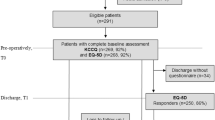Abstract
Background. The intention of this study is to analyse the correlation between a visual analogue scale (VAS) and the most common preoperative comorbidity and cardiac variables in patients undergoing elective cardiac surgery. This VAS is simple, easy to register and can be used as a global measurement of quality of life (QOL). Methods. Preoperative assessment of QOL in 1351 patients, 979 men and 372 women, with a mean age of 64.5±10.5 (18-88), undergoing elective cardiac surgery between January 2003 and December 2005. QOL was measured by the EuroQol questionnaire.
Results. The mean VAS was 58.7±20.9, range 3 to 100. Univariate analysis showed a difference for sex (p=0.000), and NYHA (p=0.009) between patients with an isolated CABG and those with a combined revascularisation (p=0.05). Stepwise logistic regression analysis identified female gender (p=0.00), NYHA (p=0.00) and valve disease (p=0.03) as independent variables for a low QOL. The correlation between NYHA and QOL was low (r=-0.09, p=0.003).
Conclusion. The clinical consequence is that using this simple VAS we can identify patients with a good QOL. If these patients present for high-risk surgery, with a better quality of life as primary indication, more extended counselling regarding their QOL is recommended. (Neth Heart J 2007; 15:51-4.)

Similar content being viewed by others
References
Noyez L, Markou ALP, van Breugel FCF. Quality of life one year after myocardial revascularization. Is preoperative quality of life important? Interactive Cardiovasc Thoracic Surg 2006;5:115-20.
Brooks R, EuroQol Group. EuroQol: the current state of play. Health Policy 1996;37:53-72.
Wouters CW, Noyez L. Is no news good news? Organized followup, an absolute necessity for the evaluation of myocardial revascularization. Eur J Cardiothorac Surg 2004;26:667-70.
Eagle KA, Guyton RA, Davidoff R, Ewy GA, Fonger J, Gardner TJ, et al. ACC/AHA guidelines for coronary artery bypass graft surgery: a report of the American College of Cardiology/American Heart Association Task Force on Practice Guidelines. J Am Coll Cardiol 1999;34:1262-346.
Eagle KA, Guyton RA, Davidoff R, Edwards FH, Ewy GA, Gardner TJ, et al. ACC/AHA 2004 Guideline Update for coronary artery bypass surgery. Circulation 2004;110:e340-e437.
Wilson IB, Clearly PD. Linking clinical variables with healthrelated quality of life. A conceptual model of patient outcomes. JAMA 1995;273:59-65.
Gill TM, Feinstein AR. A critical appraisal of the quality of qualityof- life measurements JAMA 1994;272:619-26.
Cantril H. Discovering people’s aspirations: The method used. In Cantril H (ed), The Pattern of Human Concerns. New Jersey: Rutgers University Press, 1965:21-29.
Arnold R, Ranchor AV, Sanderman R, Kempen GIJM, Omel J, Suurmeyer TPBM. The relative contribution of domains of quality of life to overall quality of life for different chronic diseases. Qual Life Tes 2004;13:883-96.
Bute PB, Blumenthal MJ. Female gender is associated with impaired quality of life 1 year after coronary artery bypass surgery. Psychosom Med 2003;65:944-51.
Failde I, Ramos I. Validity and reliability of the SF-36 Health Survey Questionnaire in patients with coronary artery disease. J Clin Epidemiol 2000;53:359-65.
Chocron S, Etievent JP, Viel JF, Dussaucy A, Clement F, Alwan K, et al. Prospective study of quality of life before and after open heart operations. Ann Thorac Surg 1996;61:153-7.
Grandjour A, Lautrbach KW. Review of quality-of-life evaluations in patients with angina pectoris. Pharmacoeconomics 1999;16:141- 52.
Pocock SJ, Henderson RA, Seed P, Treasure T, Hampton JR. Quality of life, employment status, and anginal symptoms after coronary angioplasty or bypass surgery: 3-year follow-up in Randomized Intervention Treatment of Angina (RITA) trial. Circulation 1996;94:135-42.
Rumsfeld JA, Magid DJ, O’Brien M, McCarthy M, McWhinney S, Shroyer LW, et al. Change in health-related quality of life following coronary artery bypass graft surgery. Ann Thorac Surg 2001; 72:2026-32.
Author information
Authors and Affiliations
Additional information
Heart Centre, Radboud University Medical Centre, Nijmegen, the Netherlands
Correspondence to: L. Noyez, Department of Thoracic and Cardiac Surgery, 677, PO Box 9101, 6500 HB Nijmegen, the Netherlands
Rights and permissions
About this article
Cite this article
Markou, A.L.P., Noyez, L. Will cardiac surgery improve my quality of life?. NHJL 15, 51–54 (2007). https://doi.org/10.1007/BF03085954
Issue Date:
DOI: https://doi.org/10.1007/BF03085954




